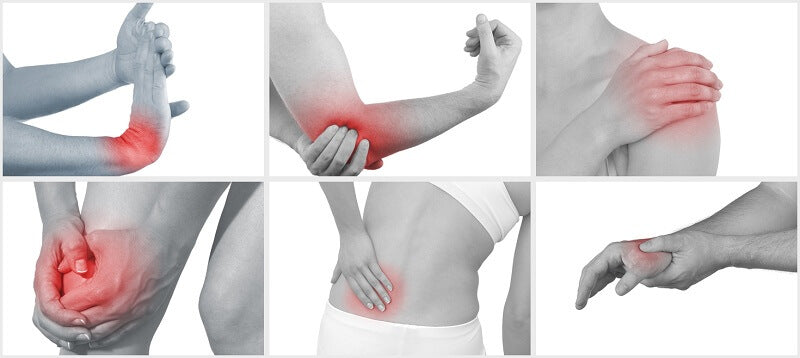Muscle Strains
What it is:
A muscle strain, or "pulled muscle," occurs when a muscle or tendon is overstretched or torn. It often happens during quick, explosive movements, like sprinting or lifting weights with improper form.
Symptoms:
- Sudden sharp pain during exercise
- Swelling or bruising
- Muscle weakness or stiffness
Common causes:
- Skipping warm-ups
- Lifting weights that are too heavy
- Using improper form during exercises
- Lack of flexibility or muscle imbalance
How to avoid it:
- Warm up properly: Spend at least 5-10 minutes warming up with light cardio and dynamic stretches.
- Progress gradually: Start with lighter weights or lower intensity and increase gradually.
- Practice proper form: Focus on controlled, smooth movements rather than speed or excessive weight.
- Incorporate flexibility training: Regularly stretch and engage in mobility exercises to improve range of motion.

Joint Sprains
What it is:
A sprain is the overstretching or tearing of ligaments, the tough tissues that connect bones at joints. Sprains are common in areas like the ankles, knees, and wrists and usually happen when a joint is forced beyond its normal range of motion.
Symptoms:
- Sudden pain in the joint
- Swelling and bruising
- Limited movement of the joint
Common causes:
- Improper landing during jumps
- Twisting or rolling the ankle
- Lifting weights with poor wrist or knee alignment
- Losing balance during a workout
How to avoid it:
- Wear supportive footwear: Especially for activities like running or jumping, proper shoes can provide stability.
- Strengthen stabilizer muscles: Incorporate exercises that target the muscles around your joints to provide better support and balance.
- Focus on balance and control: Slow down your movements and focus on keeping joints aligned and stable during exercises.
- Pay attention to surfaces: Uneven or slippery surfaces can increase the risk of sprains, so ensure a safe workout environment.

Tendinitis
What it is:
Tendinitis is the inflammation or irritation of a tendon, which is the tissue that connects muscles to bones. It’s a common overuse injury caused by repetitive movements, often in the shoulders, elbows, knees, or Achilles tendon.
Symptoms:
- Dull ache in the affected area
- Tenderness and mild swelling
- Pain worsens with movement or exercise
Common causes:
- Repetitive strain from exercises like running, jumping, or lifting weights
- Improper form or technique
- Overtraining without adequate rest
- Weakness or imbalance in the surrounding muscles
How to avoid it:
- Incorporate rest days: Allow your body to recover between intense workouts to prevent overuse.
- Vary your workouts: Avoid repetitive movements by mixing up your routine and focusing on different muscle groups.
- Strengthen supporting muscles: Build strength evenly around joints to reduce stress on tendons.
- Use proper equipment and form: Ensure your form is correct, and consider using joint-friendly equipment like resistance bands if necessary.

Lower Back Injuries
What it is:
Lower back injuries, such as strains or disc herniations, are common during weightlifting exercises like deadlifts or squats. These injuries are often caused by improper lifting techniques or overloading the spine.
Symptoms:
- Sharp or stabbing pain in the lower back
- Stiffness and difficulty standing up straight
- Pain that radiates down the legs (in the case of disc injuries)
Common causes:
- Lifting heavy weights with poor form
- Rounding or arching the back during exercises
- Weak core muscles that fail to support the spine
- Overloading the spine without adequate recovery
How to avoid it:
- Focus on proper form: Always maintain a neutral spine (a straight, aligned back) when lifting.
- Strengthen your core: A strong core provides the necessary support for your lower back during heavy lifts.
- Lift with your legs, not your back: When lifting weights off the ground, hinge at your hips and bend your knees to lift with your legs.
- Don’t overload: Gradually increase weight to avoid placing too much strain on your lower back too quickly.

Rotator Cuff Injuries
What it is:
The rotator cuff is a group of muscles and tendons that stabilize the shoulder joint. Injuries to the rotator cuff can occur from repetitive overhead movements or lifting heavy weights without proper technique.
Symptoms:
- Pain or weakness in the shoulder, especially during overhead movements
- Difficulty lifting or rotating the arm
- A dull ache that worsens with activity
Common causes:
- Overhead lifting with improper form
- Repetitive movements like throwing or swimming
- Weakness or imbalance in shoulder muscles
- Lifting too much weight too soon
How to avoid it:
- Strengthen shoulder muscles: Include exercises that target the rotator cuff and shoulder stabilizers, like external rotations and face pulls.
- Avoid excessive overhead lifting: Limit the frequency of heavy overhead exercises to reduce strain on the rotator cuff.
- Warm up your shoulders: Use light weights or resistance bands to warm up the shoulder joints and muscles before lifting.
- Monitor weight increases: Gradually increase weights for overhead lifts to prevent overloading the shoulders.

Shin Splints
What it is:
Shin splints are characterized by pain along the shinbone (tibia) and are commonly experienced by runners or individuals engaging in high-impact activities. They’re often caused by overuse, improper footwear, or running on hard surfaces.
Symptoms:
- Dull or sharp pain along the front of the shin
- Tenderness or swelling in the shin area
- Pain that worsens with physical activity
Common causes:
- Overtraining, especially with running or jumping
- Running on hard surfaces like concrete
- Wearing improper or worn-out shoes
- Weak lower leg muscles
How to avoid it:
- Gradually increase activity: If you're new to running or high-impact sports, start slow and increase intensity gradually.
- Choose soft surfaces: Whenever possible, run on softer surfaces like grass or tracks to reduce the impact on your shins.
- Wear supportive shoes: Invest in proper running shoes that offer good arch and heel support.
- Strengthen your calves and feet: Include exercises that target the muscles in your lower legs to improve strength and reduce strain.

Knee Injuries
What it is:
Knee injuries are one of the most common workout-related problems, especially in sports or exercises that involve jumping, running, or heavy lifting. These injuries can include strains, sprains, meniscus tears, or even damage to the ligaments like the ACL (anterior cruciate ligament).
Symptoms:
- Pain or tenderness in the knee
- Swelling and difficulty bending or straightening the knee
- A popping sensation during the injury (in the case of ligament tears)
Common causes:
- Poor landing technique during jumps
- Overloading the knees with heavy squats or leg presses
- Running or jumping on hard surfaces
- Weak hip or glute muscles, leading to knee misalignment
How to avoid it:
- Strengthen surrounding muscles: Focus on strengthening your quads, hamstrings, and glutes to better support your knees.
- Pay attention to alignment: Ensure your knees stay in line with your toes during squats, lunges, and jumps.
- Use proper footwear: Wear shoes that provide good arch and ankle support, especially for high-impact activities.
- Avoid hard surfaces: When possible, run or train on softer surfaces, such as tracks or grass, to reduce impact on the knees.

Conclusion
Injuries can happen to anyone, but with the right strategies, they are often preventable. Prioritizing warm-ups, focusing on proper form, progressing gradually, and listening to your body are the keys to staying injury-free during your workouts. Taking care of your body will not only help you avoid setbacks but also ensure long-term success in your fitness journey.
Stay smart, stay safe, and keep working toward your fitness goals!

